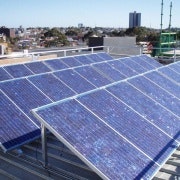Goldilocks and the solar target
The Clean Energy Regulator recently announced that the 2013 Target for small-scale renewable energy certificates or STCs would be 35.7 million, of which 15m was to soak up 2012's over-creation. The market responded immediately with a $2 increase in the price offered by major aggregators, suggesting it thought this was a higher target than expected. But it’s not all good news, indeed the target implies a contraction in the solar market by 20-25%, and in the meanwhile there will be new market dynamics to watch out for.
The 2013 STC target implies an expected market contraction for the solar power sector, something foreshadowed when SunWiz & SolarBusinessServices released our Forecast 2012-2017 two weeks ago. Ric Brazzale of Green Energy Markets confirms that the market implication is for 780MW of small-scale PV to be installed in 2013.
The reason for the sharp price rise was that this 20.7m target was higher than the initial October 2012 modelling of 18.46m STCs. Also the initial target estimate was developed prior to the early reduction of the STC multiplier; hence the 20.7m target is substantially higher than the market expected.
But the market has over-delivered on the Regulator's expectations for two years in a row, what's to say this won't happen again? So, is the estimate too high, too low, or just right?
Even if the target is out in 2013, it won't be so far out as in previous years, when it underestimated the market by 50%. In those years, state government policies provided drivers for PV uptake that fuelled early multiplier reductions which only fanned the flames. The price signal provided by a declining STC price was outweighed by the installation incentives provided by pending reduction in feed-in tariffs and solar multiplier.
In 2013 there can be no further multiplier reduction, and government policy in states with feed-in tariffs (SA and QLD) is well known, which wasn't the case in previous years. These have been accounted for in the 2013 STC target, and are remnant parts of a larger market. Thus, the STC price signal should act more effectively to reduce oversupply should it occur; (which could be foreshadowed by unexpected installation volumes in either state).
The feedback loop will compensate for oversupply, but what if there's undersupply? It’s worth remembering that just reaching the target implies a significant contraction for the PV market, complete with margin pain and business exits. Should market conditions turn unfavourable, the $40 price cap limits the additional incentive available to coax customers out of the woodwork. However, it’s my opinion that the STC value is now a small component of PV system pricing, and shouldn't be the sole solar make-or-break factor.
The long-awaited Clearing House* will introduce new dynamics to the STC market. The STC market is designed that over the long term demand should equal supply, so the Clearing House should come into play at some stage. Preliminary analysis by SunWiz for its ClearView subscribers shows that this could be as early as the third quarter, depending upon the installation volumes particularly for Queensland's remaining Feed-in Tariff applicants, and the timing of sales for the rest of the market. Presently there are some 4.6m STCs in the Clearing House, a volume that decreases marginally each week.
Once the Clearing House queue finally moves, the dynamics get interesting. This might spark a rush to the Clearing House, as STC holders finally cash-in (and avoid fees from middle-men). But before that happens, there would have to be some people waiting at the end of the Clearing House queue who calculate that they're not going to get to the front this quarter, and who don't want to risk another year waiting, so they take a price in the high thirties. In doing so, they will have jumped the queue, extending the wait for others in the Clearing House. ClearView shows that a bank is one of the biggest holders of STCs in the Clearing House queue, so their behaviour may be the most illuminating to watch. There may be bets placed on how many STCs shift in each quarter; that way those at the back of the line may win even if they lose.
Is the target too low (again)?
Before you get too excited about the prospect of the Clearing House handing out the long-awaited $40, you may want to consult a copy of our recently completed Australian PV Installation Forecast 2012-2017. Firstly, our pessimistic forecast is considerably lower than the target, which would imply an unhappy PV industry (at least in most sectors other than the key areas of opportunity identified in the report). Perhaps more happily, our mid-range scenario exceeds the Regulator's forecast by a noteworthy margin, though this news may not excite those in the Clearing House. Our most optimistic scenario, driven by key areas of opportunity, shows that there is still some room for growth in 2013 - as much as 1.2GW when large-scale PV is included.
Warwick Johnston is Managing Director of Sunwiz Consulting
This article was originally produced by Sunwiz, republished with permission.
* Explanation of the ‘Clearing House’: Owners of STCs have the option of selling their STCs immediately to energy retailers (usually via brokers) or they can place them into what is known as the Clearing House which is managed by the Clean Energy Regulator. If a retailer cannot acquire sufficient STCs to meet their requirements via direct purchases then they will need to acquire STCs from the Clearing House. These are sold for a fixed price of $40 per STC. The Clearing House operates on a first in, first out queuing basis, so those who placed their STCs into the clearing house the earliest are sold first to retailers. Placing STCs into the Clearing House involves a risk for sellers that there may be a long delay between when STCs are placed into the Clearing House and when they are sold.













